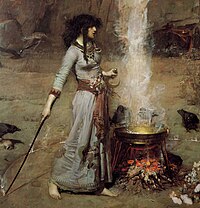This article has multiple issues. Please help improve it or discuss these issues on the talk page. (Learn how and when to remove these messages)
|
| Part of a series on |
| Witchcraft |
|---|
 |
Witchcraft in Latin America, known in Spanish as brujería (pronounced [bɾuxeˈɾi.a])[1][2] and in Portuguese as bruxaria (pronounced [bɾuʃaˈɾi.ɐ]), is blend of Indigenous, African, and European beliefs. Indigenous cultures had spiritual practices centered around nature and healing, while the arrival of Africans brought syncretic religions like Santería and Candomblé. European witchcraft beliefs merged with local traditions during colonization. Practices vary across countries, with accusations historically intertwined with social dynamics. A male practitioner is called a brujo, a female practitioner is a bruja.[3]
In Colonial Mexico, the Mexican Inquisition showed little concern for witchcraft; the Spanish Inquisitors treated witchcraft accusations as a "religious problem that could be resolved through confession and absolution". Belief in witchcraft is a constant in the history of colonial Brazil, for example the several denunciations and confessions given to the Congregation for the Doctrine of the Faith of Bahia (1591–1593), Pernambuco and Paraíba (1593–1595).[4]
Anthropologist Ruth Behar writes that Mexican Inquisition cases "hint at a fascinating conjecture of sexuality, witchcraft, and religion, in which Spanish, indigenous, and African cultures converged".[5] There are cases where European women and Indigenous women were accused of collaborating to work "love magic" or "sexual witchcraft" against men in colonial Mexico.[6] According to anthropology professor Laura Lewis, "witchcraft" in colonial Mexico represented an "affirmation of hegemony" for women and especially Indigenous women over their white male counterparts in the casta system.[7]
- ^ María Herrera-Sobek (2012). Celebrating Latino Folklore: An Encyclopedia of Cultural Traditions. ABC-CLIO. p. 174. ISBN 978-0-313-34339-1.
- ^ "brujería". Pop Culture Dictionary, by Dictionary.com. Retrieved 2020-02-24.
- ^ Herrera-Sobek (2012), p. 175.
- ^ (in Portuguese) João Ribeiro Júnior, O Que é Magia, pp. 48–49, Ed. Abril Cultural.[ISBN missing]
- ^ Behar, Ruth (1987). "Sex and Sin, Witchcraft and the Devil in Late-Colonial Mexico". American Ethnologist. 14 (1): 34–54. doi:10.1525/ae.1987.14.1.02a00030. hdl:2027.42/136539. JSTOR 645632.
- ^ Lavrin, Asunción (1989). Sexuality and marriage in colonial Latin America. Lincoln: University of Nebraska Press. ISBN 9780803228856. LCCN 88033980. OL 2055674M.
- ^ Lewis, Laura A. (2003). Hall of Mirrors: Power, Witchcraft, and Caste in Colonial Mexico. Durham, NC: Duke University Press. p. 13. ISBN 978-0822331476.